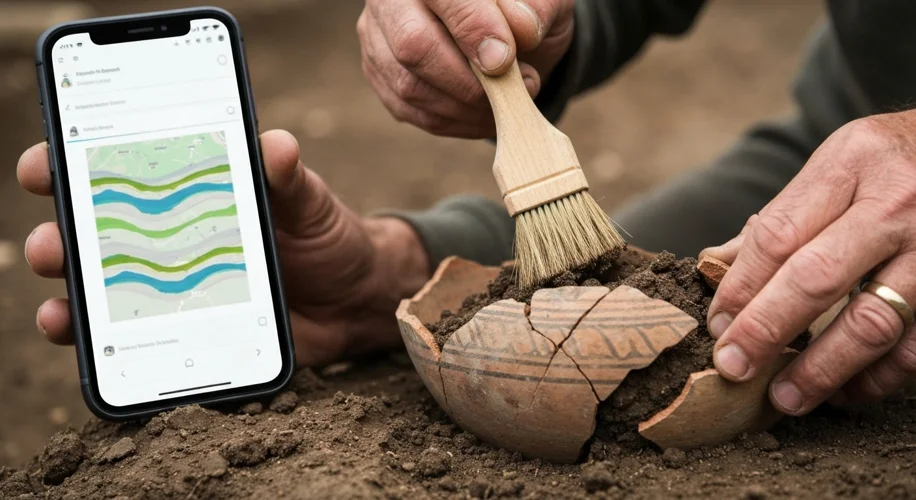Imagine walking through a sun-drenched field, a gentle breeze rustling the crops. Your foot nudges something hard. You kneel, brush away the soil, and reveal a shard of pottery, its glaze still faintly vibrant after centuries buried. Or perhaps it’s a glint of metal – a coin, a buckle, a weapon’s pommel. These moments of connection with the past are thrilling, sparking a curiosity about the hands that shaped these objects, the lives they touched, and the stories they hold.
But where do these thrilling discoveries go? For the amateur historian, the weekend archaeology enthusiast, or even the seasoned professional stumbling upon something in an unexpected place, the path from discovery to documented knowledge is often fraught with complexity. There isn’t a readily available, user-friendly platform that functions like iNaturalist for the natural world, where you can snap a photo, identify a species, and contribute to a global database of biodiversity.
Consider the case of an ordinary citizen unearthing what appears to be Roman-era pottery in their backyard in Britain. They might contact a local museum or university, but the process can be slow, and the artifact may end up in a dusty basement, rarely seen or studied. Or perhaps they find a corroded button on a battlefield in France – was it a soldier’s uniform, and from which conflict? Without a centralized, accessible system, these individual discoveries, though seemingly small, can remain isolated fragments, their potential to contribute to a larger historical narrative lost.
This absence highlights a significant gap in how we engage with archaeological heritage. We have incredible digital tools for mapping the stars, tracking wildlife, and even identifying plant species, yet a similar, accessible platform for the tangible remnants of human history remains largely a dream.

What would such a platform entail? At its core, it would need to be an accessible digital space where anyone, anywhere, can document their finds. This would involve:
- User-Friendly Cataloging: Simple upload of photos, location data (with privacy options for sensitive sites), descriptions, and context of the find. Think of it as a citizen-science endeavor for history.
- AI-Powered Identification Assistance: Leveraging machine learning, the platform could offer preliminary identifications, suggesting possible periods, cultures, or types of artifacts based on visual and contextual data. Imagine uploading a photo of a Roman coin and getting suggestions for its possible emperor and mint date.
- Geospatial Tagging and Mapping: Visualizing discoveries on a map would be crucial, allowing users and researchers to see patterns, identify potential areas of interest, and understand the distribution of artifacts across regions.
- Expert Verification and Collaboration: While user contributions would be vital, a system for verification by archaeologists and historians would lend credibility. This could involve a peer-review system or designated moderators.
- Educational Resources: Integrating information about artifact care, ethical discovery practices, and the history of archaeological interpretation would be essential for responsible engagement.
Imagine the potential: a vast, crowdsourced atlas of human history, built piece by piece by people around the globe. Enthusiasts could virtually explore discoveries made in their own towns or faraway lands, contributing to a shared understanding of our collective past. Researchers could identify overlooked patterns, pinpoint areas for targeted excavation, and even collaborate more effectively on international projects. The sheer volume of data could unlock new insights into migration patterns, trade routes, and the daily lives of our ancestors.
However, the creation and maintenance of such a platform are not without their challenges. The primary hurdle is the ethical and legal landscape surrounding artifact discovery. Looting and illicit trade in antiquities are serious global issues. Any platform would need robust safeguards to prevent its misuse for facilitating such activities. This might involve anonymizing precise locations for certain types of finds or working closely with archaeological authorities and heritage organizations.
Furthermore, data quality and verification are paramount. How do we ensure that the information being contributed is accurate and not based on misidentification or even fabrication? The AI assistance could help, but human expertise would remain indispensable. This points to the need for a strong community of volunteer experts willing to dedicate their time.
Funding and sustainability are also critical considerations. Building and maintaining such a complex digital infrastructure, along with managing a global community and expert network, would require significant investment and a long-term vision.
Finally, cultural sensitivity and ownership must be at the forefront. Archaeological discoveries often touch upon the heritage and identity of specific communities. The platform would need to be designed with respect for these sensitivities, perhaps incorporating features that allow local communities to have a say in how their heritage is presented and accessed.
Despite these challenges, the vision of a global, digital platform for archaeological discovery is compelling. It represents an opportunity to democratize history, empowering ordinary citizens to become active participants in uncovering and understanding our shared past. It’s a call to arms for a new generation of history detectives, equipped with smartphones and curiosity, ready to contribute their own echoes to the grand narrative of human civilization. The question isn’t whether we can build such a space, but whether we have the collective will to bring this digital treasure trove to light.

